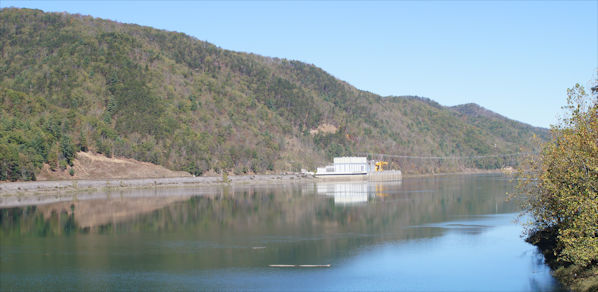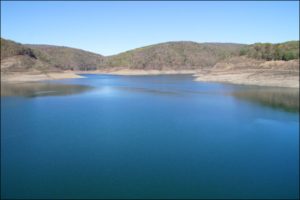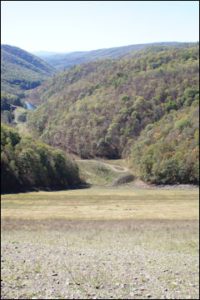
Bath County Pumped Storage Station: lower reservoir
The Bath County pumped-storage facility has worked out so well for Dominion that the utility wants to build a smaller version in Southwest Virginia.
Since its completion in 1985, the Bath County Pumped Storage Station has functioned like a giant battery, supplementing Dominion Energy Virginia’s base-load coal, nuclear and gas-fired plants with its variable output. When energy demand peaks in the early morning and evening, the Bath County facility drains water from an upper reservoir through tunnels to its hydroelectric turbines more than 1,000 feet below. Then in the evening, when demand is low, Dominion pumps water in the lower reservoir back up the mountain, in effect recharging its battery.
Bath County is capable of producing 3,000 megawatts of electricity for up to three hours at a time, making Dominion’s 60% ownership of the facility a critical component of the company’s total 19,900-megawatt generating fleet. That same flexibility will serve the company well as it integrates between 5,280 and 5,760 megawatts of intermittent solar power its system over the next two decades. Solar generates maximum power with the mid-day sun and none at night, scrambling the traditional supply-and-demand equation. Bath County will play a critical goal in keeping power output in concert with demand.
Indeed, Dominion is so enamored with its pump-storage facility that it wants another one. The utility is giving serious study to a site in Tazewell County that would be capable of generating up to 850 megawatts of electricity. Building a pumped-storage project there would cost roughly $2 billion.
Dominion is touting the Tazewell project as an economic boon for Southwest Virginia, a region whose economy is depressed from the long-term decline of the coal industry. A Tazewell pumped-storage facility would create more than 2,000 jobs during the construction phase, plus 50 permanent jobs, and would contribute $37 million to the regional economy, including $12 million in tax revenue.
With interest in the project high in Southwest Virginia, Dominion invited regional media to Bath County to see how pumped storage works. I tagged a long as the sole member of the Richmond media.
Bath County is a marvel. Most notably, the facility is the largest pumped-storage operation in the world. It produces more electricity than the Hoover dam. The earth-rock impoundment dam creating the upper reservoir reputedly is the eighth highest dam in the world. But the facility is so tucked away so deep in the mountains — it takes more than half an hour to get there from Hot Springs, location of another Bath County icon, the Homestead — that spa visitors have no idea it’s there.

The upper reservoir at the Bath County Pumped Storage Station.
The upper reservoir serves one function: to hold the water that pours through three gravity-fed tunnels at the rate of 2.2 million gallons per minute. Those tunnels split into six, and the water drives six 505-megawatt turbines. The depth of the upper reservoir, which sits at an elevation of roughly 3,000 feet, fluctuates dramatically throughout the day as the water level rises and drops.

This photo looks down at a sharp angle. The flat expanse is the rock-and-dirt impoundment dam, reputedly the world’s 8th highest dam.
Building the two reservoirs and three tunnels entailed excavation of 36.3 million cubic yards of material, quarrying 2.8 million cubic yards of rock, and pouring 1.1 million cubic yards of concrete. Dominion maintains an elaborate system of sensors and inspections to ensure that the the integrity of the structures is never compromised. Dominion staff walk the upper and lower dams weekly to look for seepage or other signs of failure. To keep the vegetation low, the company has contracted with a service to bring in goats. (Without question, the goats were the crowd-pleaser of the tour.)
The generating station, sitting at the base of the mountain, houses the turbines. The pressure created by thousand-foot columns of water with a lake above them is phenomenal.

Top-down view of the six turbines. The main structure of the unit is below ground. The component visible at the center of the photo is where the rotating brushes create magnetic fields.
The beauty of the Bath pumped-storage facility is that it can be dispatched quickly. The turbines can start generating electricity within six minutes. Within 15 minutes, they can begin pumping water back to the upper reservoir. That’s not the same flexibility provided by a real battery, which can dispatch electricity more or less instantaneously, but it is more nimble than any other conventional power source.
The hydroelectric technology is deemed low risk and high-efficiency — for five units of power consumed to pump water back up the mountain, the plant generates four units of power, making it 80% efficient. Pumped storage also has a long lifetime and low operating costs. Recent technological advances may make the Wise County facility even more responsive to fluctuations in demand than Bath. A July 2016 Department of Energy report, “Hydropower Vision: a New Chapter for America’s Renewable Electricity Source,” found that advanced pumped-storage capabilities such as adjustable-speed and closed-loop and modular designs can “further facilitate integration of variable generation, such as wind and solar, due to its ability to provide grid flexibility, reserve capacity and system inertia.”
The drawback of the Bath facility is that it can operate at full capacity, 3,000 megawatts, only three hours out of the day. When operating for extended periods, up to 11 hours, it can generate only 362 megawatts. And it can take up to 12 hours to restore the upper reservoir to its full capacity. Still, as long as Dominion has to balance supply and demand on its grid — a job that will get trickier as more intermittent solar production comes on line — and as long as there is a wide differential in the price of electricity at different times of the day, the Bath pumped-storage station will play a pivotal role in keeping the lights on in Virginia at a reasonable cost.
Whether the economics of the proposed Tazewell facility pencils out as nicely as at Bath remains to be seen. Tazewell would produce only a third of the power and construction would cost a bit more than Bath did three to four decades ago. Moreover, Dominion officials expect it will take a full decade to walk the project through the regulatory process and build the hydro plant. But unlike some infrastructure projects Dominion has been pushing recently, Tazewell would have three things going for it. One, it will have strong political support in Southwest Virginia. Second, compared to lengthy pipelines and transmission lines, the visual impact on neighbors will be negligible. And third, hydro power is not a fossil fuel, so it should win the blessing of environmentalists.


